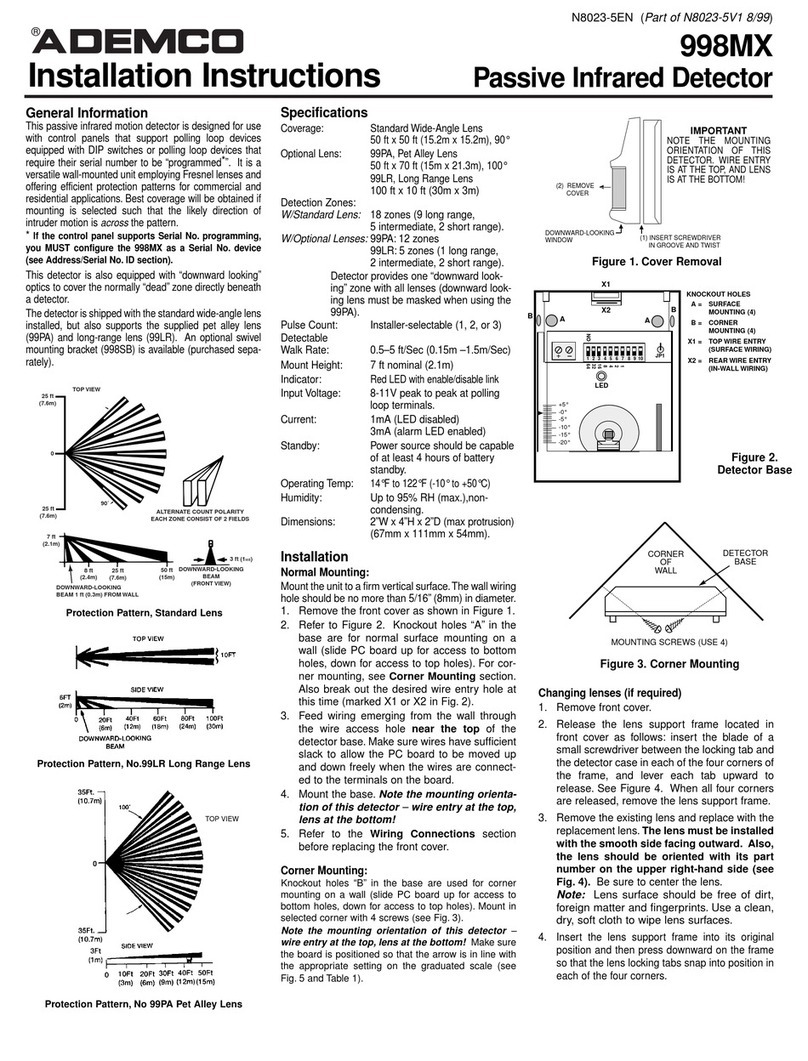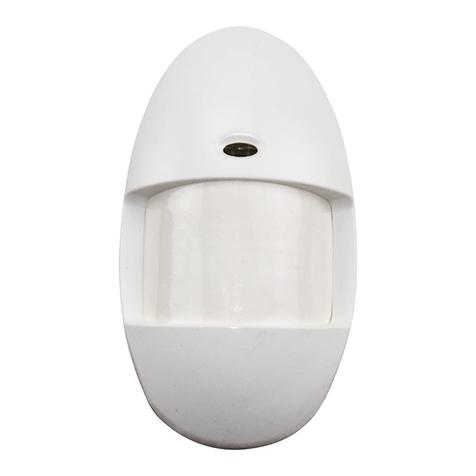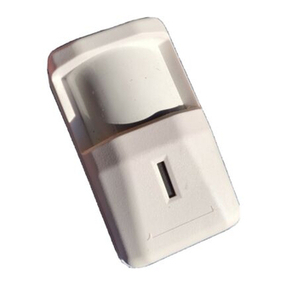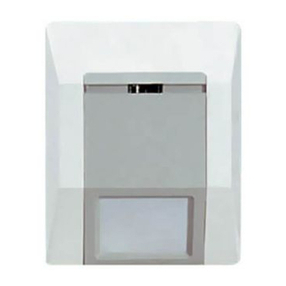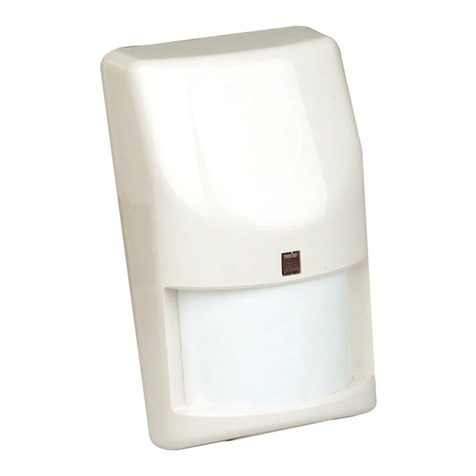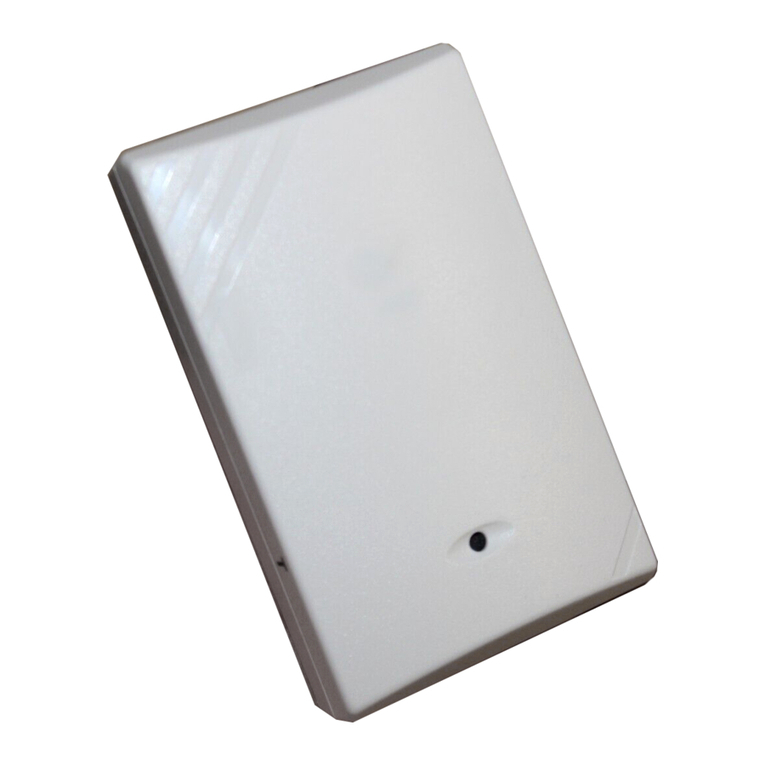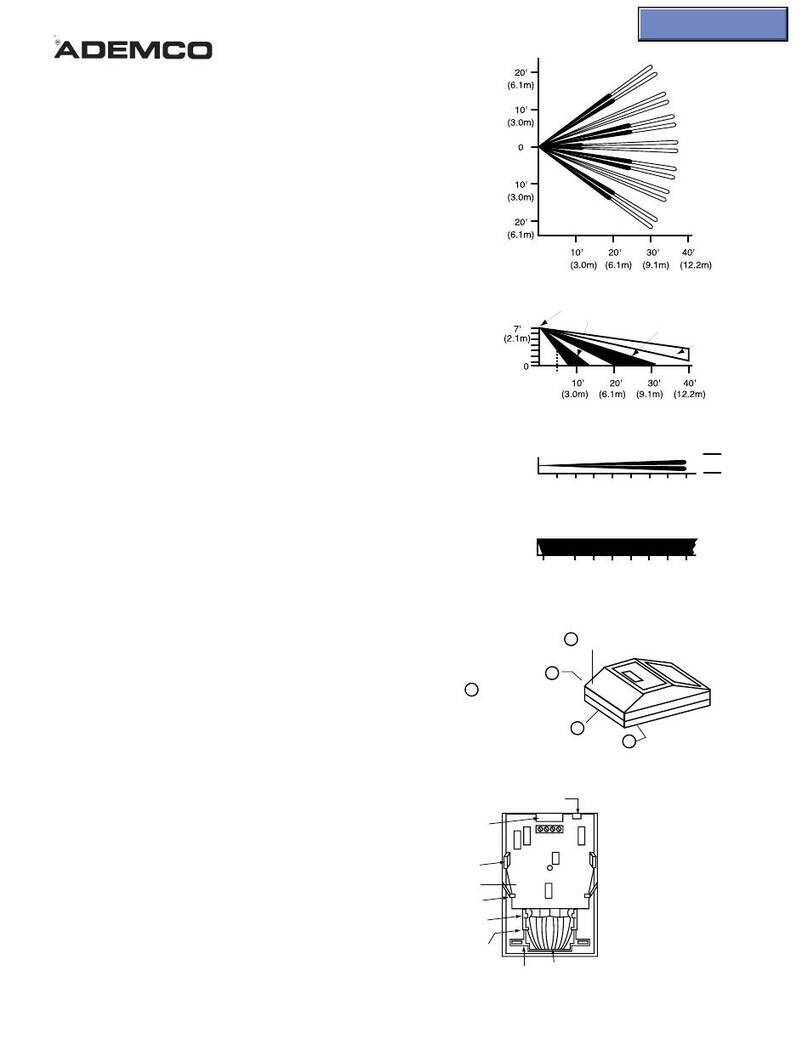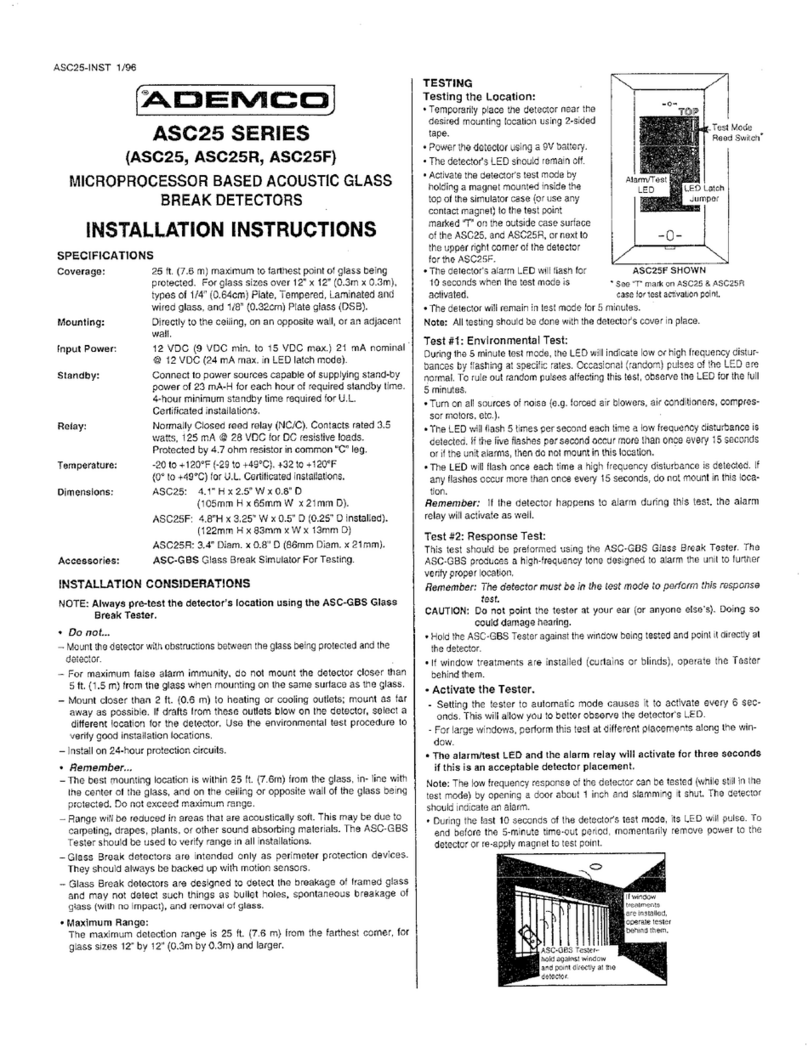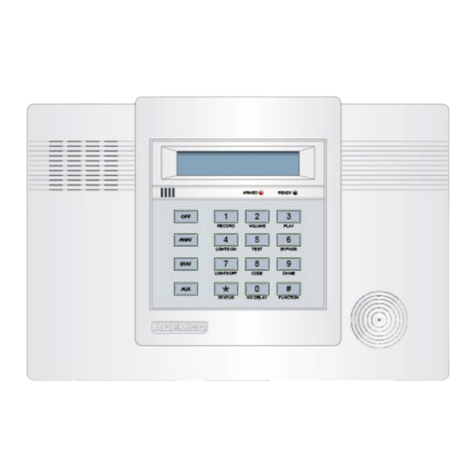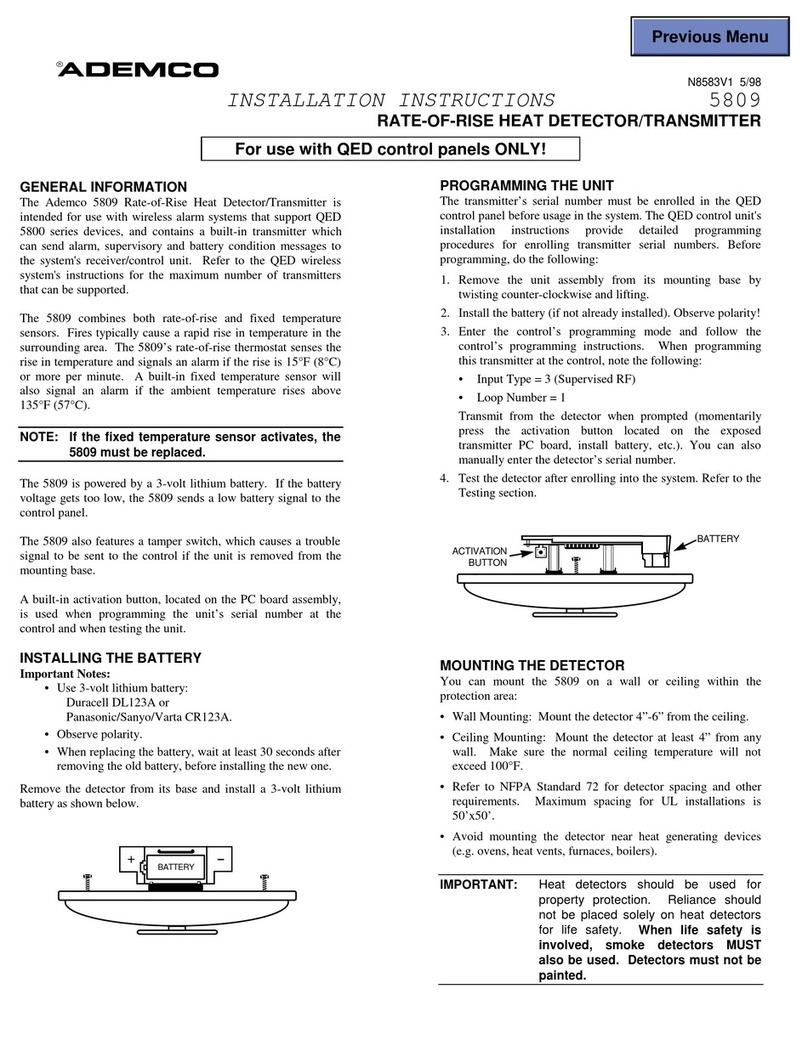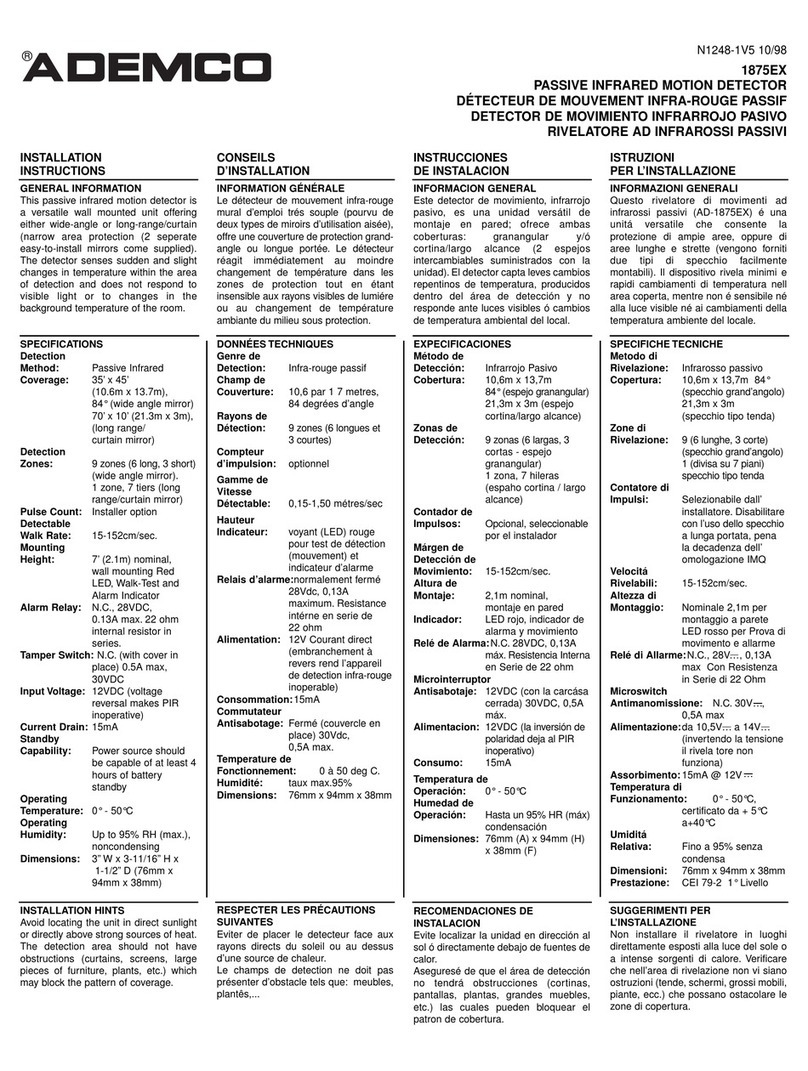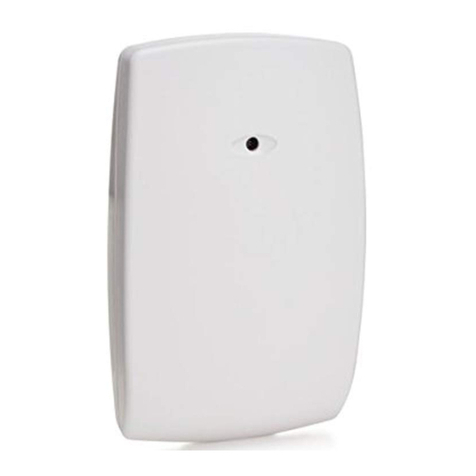
Page 3
The angle of the PIR pattern may be vertically positioned between
-10° and +2° by loosening the Vertical Adjust screw and sliding the
circuit board up or down. Moving the board up will angle the pattern
downward.Tightenthescrew snug when positioning is completed.
NOTE: The pattern may be moved ±10° horizontally by moving the lens
to the left or right.
Establishing Microwave Coverage
NOTE: Itis important to wait one minute afterremoving/replacing the
cover so the microwave portion of the detector can settle, and to
wait at least 10 seconds between the following walk testing
procedures.
• The tri-color LED should be OFF before walk testing.
• Walk test across the pattern at the intended coverage’s farthest end.
Startwalkingfromoutside the intended protection area and observe the
tri-color LED. The edge of the microwave pattern is determined by the
first yellow, microwave activation of the LED (or the first red activation if
the green PIR LED activates first).
• Ifadequaterangecannotbereached,increasetheMicro-
waveRangeAdjust slightly. Continue testing (waiting one
minute after removing/replacing the cover) and adjusting
the range until the farthest edge of desired coverage has
beenaccuratelyplaced.
Do not adjust the microwave range higher than required. Doing so
will enable the detector to catch movement outside of the intended
coverage pattern.
• Walktesttheunit from all directions to determine all the detection pattern
boundaries.
Establishing Detector Coverage
• With no motion in the protected area, the tri-color LED should be OFF
beforewalktesting.
• Walk test the unit from all directions to determine the detection bound-
aries. A detector alarm is signaled by the first red activation of the tri-
colorLED after an initial green/yellow activation.
Supervision Features
Thesupervision features function as follows:
•PIR/Microwave: If the PIR or microwave subsystem fails, the tri-color
LEDwill flash red four times per cycle.The complete circuit operation of
these subsystems is checked approximately every 12 hours.
•Default: The detector will default to PIR technology protection if the
microwavesubsystem fails. When defaulting to PIR, thePIR signal pro-
cessing will change from INT to STD.
Other Information
Maintenance: Atleast once a year, the range andcoverage should be
verified. To ensure continual daily operation,the end user should be
instructed to walk through the far end of the coverage pattern. This
ensures an alarm output prior to arming the system.
Pattern Masking: The PIR coverage pattern may be masked using
masking tape or electrical tape on the inside of the lens.
NOTE: Maskingonly eliminates the PIR portion of the coverage and has
noeffectonthe microwave pattern.
U.S. Patent Numbers: #4,660,024,#4,764,755,#5,077,548,#5,208,567,
#5,262,783, #5,450,062,and#5,670,943.Otherpatentspending.
TO THE INSTALLER
Regularmaintenance and inspection (at least annually) bythe installer
and frequent testing by the user are vital to the continuous satisfactory
operationof any alarm system.
Theinstaller should assume the responsibility ofdeveloping and offeringa
repairmaintenance program to the user,as well as acquaintingthe user
withthe proper operation and limitations of the alarm system and its
componentparts. Recommendations must be included for aspecific
program of frequent testing (at least weekly) to insure the systems
operationatall times.
WARNING!
THE LIMITATIONS OF YOUR
MICROWAVE/PASSIVE MOTION DETECTOR
Whilethis Intrusion Detector is a highly reliable intrusion device, it does
notofferguaranteedprotectionagainstburglary.AnyIntrusionDetection
device is subject to compromise or failure to warn for a variety of reasons.
Forexample:
• TheseMotion Detectors can only detect intrusion withinthe designated
rangesasdiagrammedin this installation manual.
• The passive infrared sensor in this Motion Detector does not provide
volumetric area protection. It does create multiple beams of protection,
and intrusion can only be detected in unobstructed areas covered by
thosebeams.
• Passive Infrared Detectors cannot detect motion or intrusion that takes
placebehind walls, ceilings, floors, closed doors, glasspartitions, glass
doors, or windows.
• Metalobjects(orotherreflectors,suchasfoilfaced insulation or water in
bottles)can alter the microwave sensor’sprotectionpattern.
• Mechanicaltampering,masking,paintingor spraying of any material on
the lenses, windows or any part of the optical system can reduce the
detectionability of the Passive Infrared Motion Detector.
• PassiveInfraredDetectorssense changes in temperature; however,as
theambienttemperatureofthe protected area approaches the tempera-
turerangeof 90° to 105°F (32° to 40°C),thedetectionperformance can
decrease.
• The detector will not operate without appropriate DC power connected
to it, or if the DC power is improperly connected (i.e., reversed polarity
connections).
• TheseDetectors,likeotherelectricaldevices,aresubjecttocomponent
failure. Even though this equipment is designed to last as long as 10
years, the electronic components could fail at any time.
We have cited some of the most common reasons that this Motion
Detector can fail to catch intrusion. However, this does not imply that
these are the only reasons, and therefore it is recommended that weekly
testing of this type of unit, in conjunction with weekly testing of the entire
alarm system, be performed to ensure that the detectors are working
properly.
Installing an alarm system may make the owner eligible for a lower
insurance rate, but an alarm system is not a substitute for insurance.
Homeowners,property owners and renters should continueto act
prudentlyin protecting themselves and continue toinsure their lives and
property.
Wecontinueto develop new and improvedprotection devices. Users of
alarm systems owe it to themselves and their loved ones to learn about
thesedevelopments.
www.PDF-Zoo.com

